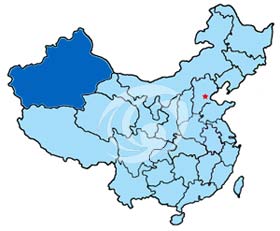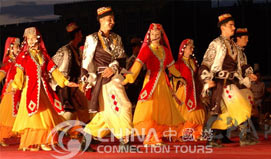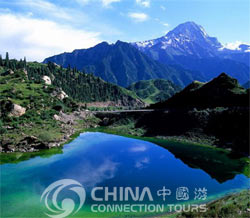Geographic location
 The Xinjiang Uygur Autonomous Region is situated in northwestern China on the hinterland of the Eurasian Continent. Occupying an area of 1.7 million square kilometers and accounting for one sixth of Chinese territory, Xinjiang is the largest of China's regions and provinces. It shares 5,600 km of borderland with Mongolia in the northeast, Russia, Kazakhstan, Kyrgyzstan and Tajikistan in the west, and Afghanistan, Pakistan and India in the southwest, making Xinjiang an important strategic area throughout history. It served as a key section of the Silk Road and is now a crucial link of the railway leading to the second Eurasian Continental Bridge.
The Xinjiang Uygur Autonomous Region is situated in northwestern China on the hinterland of the Eurasian Continent. Occupying an area of 1.7 million square kilometers and accounting for one sixth of Chinese territory, Xinjiang is the largest of China's regions and provinces. It shares 5,600 km of borderland with Mongolia in the northeast, Russia, Kazakhstan, Kyrgyzstan and Tajikistan in the west, and Afghanistan, Pakistan and India in the southwest, making Xinjiang an important strategic area throughout history. It served as a key section of the Silk Road and is now a crucial link of the railway leading to the second Eurasian Continental Bridge.
The landscape of Xinjiang is characterized by alternating mountains and basins. To the north lie the Altai Mountains and in the south are the Kunlun Mountains. The Tianshan Mountains lie in the middle dividing Xinjiang into two parts. The Tarim Basin stretches to the south; the Jungar Basin stretches in the north. In the center part of the Tarim Basin stretches the Taklimakan Desert, the largest mobile desert in China and the second largest in the world. The 2,100-km-long Tarim River is the longest continental river in China. In the east of Xinjiang, Turpan Basin is the lowest point in China, 154 meters below sea level, and second lowest in the world after the Dead Sea.
Xinjiang experiences an extra tropical belt continental climate. As 2001, the annual precipitation in Xinjiang amounted to only 100 mm. Many rivers flow from the mountains due to snow melt. Oases lie on the edges of basins and in the river valleys, taking up only 5% of the province's area.
 Since ancient times, Xinjiang has been inhabited by many ethnic groups with a number of religions. Recorded history in the region began in the Western Han dynasty (206 BC-24 AD), when invaders sought control over this key trade route. Following the Han dynasty, Buddhism took hold in the region, bringing with it foreign culture and ideas. The Tang dynasty reasserted Chinese control in the seventh century and saw the emergence of the Uygur minority. Islam did not arrive in the region until the fourteenth century, when the Mongols took control of the region. Since the founding of the People's Republic of China, many people and resources have been pumped into the region to encourage economic growth and stability.
Since ancient times, Xinjiang has been inhabited by many ethnic groups with a number of religions. Recorded history in the region began in the Western Han dynasty (206 BC-24 AD), when invaders sought control over this key trade route. Following the Han dynasty, Buddhism took hold in the region, bringing with it foreign culture and ideas. The Tang dynasty reasserted Chinese control in the seventh century and saw the emergence of the Uygur minority. Islam did not arrive in the region until the fourteenth century, when the Mongols took control of the region. Since the founding of the People's Republic of China, many people and resources have been pumped into the region to encourage economic growth and stability.
As the main hub for economic and cultural exchanges between the East and the West in ancient times, Xinjiang has always been a region where a number of religions exist side by side. Before Islam was introduced into Xinjiang, there had already been Zoroastrians, Buddhists, Taoists, Manicheans and Nestorians. These religious believers spread to Xinjiang along the Silk Road and thrived together with the local primitive religions.
With a population of over 20 million, Xinjiang is home to 47 ethnic groups, mainly Uygur, Han, Kazak, Hui, Mongolian, Kirgiz, Xibe, Tajik, Uzbek, Manchu, Daur, Tatar and Russian.
Xinjiang boasts unique and beautiful landscapes, with snow-capped mountains, stifling deserts, and verdant oases. Some famous scenic spots are Tianchi Lake, Kanas Lake, Bosten Lake and Bayanbulak Grassland. Over 1,000 species of animals and plants thrive in Xinjiang, including many unique to the region. There are 23 natural reserves, four of which are recognized on the national level.
 Xinjiang is also rich in cultural resources. The ancient Silk Road had three routes across Xinjiang totaling over 5,000 km. Along these ancient highways are hundreds of cultural sites such as ancient cities, tombs, Buddhist caves, garrisons, and cultivated land. Many are well-known at home and abroad: Jiaohe Ancient City, Gaochang Ancient City, Loulan Ancient City, Kizil Thousand-Buddha Grotto and3 Apak Hoja Tomb (commonly known as Xiangfei Tomb). Xinjiang is also known as the home of songs and dance. The art and customs of the many ethnicities provide the region with a rich cultural fabric.
Xinjiang is also rich in cultural resources. The ancient Silk Road had three routes across Xinjiang totaling over 5,000 km. Along these ancient highways are hundreds of cultural sites such as ancient cities, tombs, Buddhist caves, garrisons, and cultivated land. Many are well-known at home and abroad: Jiaohe Ancient City, Gaochang Ancient City, Loulan Ancient City, Kizil Thousand-Buddha Grotto and3 Apak Hoja Tomb (commonly known as Xiangfei Tomb). Xinjiang is also known as the home of songs and dance. The art and customs of the many ethnicities provide the region with a rich cultural fabric.

